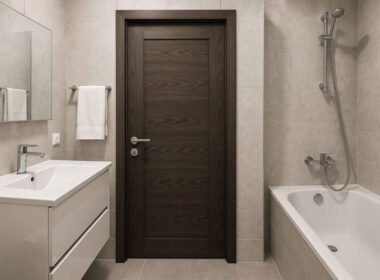Maintaining clean and sanitary bathrooms in commercial spaces is more than just a matter of aesthetics—it directly impacts health, safety, and customer perception, notes management solutions from Specialized Property Management. From offices and restaurants to shopping centers and healthcare facilities, high-traffic bathrooms require consistent attention to detail. Implementing the right strategies ensures that restrooms remain hygienic, welcoming, and compliant with health standards. Here’s how to effectively manage bathroom upkeep in commercial environments.
-
Establish a Regular Cleaning Schedule
A structured cleaning schedule is the backbone of maintaining hygiene. Bathrooms in commercial spaces see heavy daily use, making frequent cleaning essential. Start by setting cleaning intervals based on traffic volume. For example, restrooms in busy locations may need hourly inspections, while those in low-traffic areas might only require cleaning several times a day.
Focus on high-touch surfaces such as door handles, faucets, flush buttons, and soap dispensers. Regularly disinfecting these areas minimizes the spread of germs. It’s also important to maintain a log of cleaning activities, ensuring accountability and consistency.
-
Stock Supplies and Consumables Adequately
Few things are more frustrating than finding empty soap dispensers or missing paper towels in a restroom. Keeping an ample stock of supplies not only supports hygiene but also improves user satisfaction. Make it a priority to:
- Refill soap dispensers and hand sanitizers frequently.
- Restock toilet paper, paper towels, and tissues.
- Replace air fresheners and toilet seat covers when needed.
Consider placing backup supplies in accessible storage cabinets for quick replenishment. Automated systems, such as touchless dispensers, can also help control usage and reduce waste.
-
Focus on Deep Cleaning and Preventative Maintenance
Daily cleaning addresses surface-level issues, but deep cleaning is equally important. Schedule periodic deep cleaning sessions to target buildup in hard-to-reach areas, including grout lines, drains, and ventilation systems. Mold and mildew can accumulate quickly in moist environments, posing health risks if not properly managed.
Preventative maintenance also plays a critical role in avoiding costly repairs. Inspect plumbing systems regularly for leaks, clogs, or worn-out fixtures. Ensure all equipment, including hand dryers and faucets, functions properly to provide a seamless experience for users.
-
Optimize Layout and Fixtures for Hygiene
Designing a bathroom layout with hygiene in mind can make cleaning more effective and promote better habits among users. Incorporating features such as touchless faucets, motion-sensor flush systems, and automatic hand dryers reduces contact points and lowers contamination risks.
In addition, pay attention to washroom stall dimensions to ensure accessibility and comfort. Proper spacing allows for easier cleaning while meeting ADA compliance requirements. A well-designed restroom layout not only enhances functionality but also reflects positively on your business.
-
Address Odor Control Effectively
Even a clean restroom can feel uninviting if it has lingering odors. Proper ventilation is key to maintaining fresh air circulation and removing moisture that can lead to mildew. Air fresheners and odor-neutralizing sprays offer quick fixes, but long-term solutions include installing exhaust fans and dehumidifiers.
Regularly emptying trash bins and cleaning drains also prevent odor buildup. For added freshness, consider using scented urinal screens or automatic air diffusers.
-
Provide Clear Signage and Encourage Good Hygiene Practices
Encouraging proper hygiene habits among users can make a significant difference. Post clear signage reminding individuals to wash their hands, dispose of paper towels properly, and report maintenance issues. Signs should be simple, visually engaging, and placed at eye level near sinks and mirrors.
Adding reminders about eco-friendly practices, like conserving water and paper products, promotes sustainability without compromising cleanliness.
-
Train Cleaning Staff for Efficiency and Safety
Well-trained cleaning staff are essential for maintaining hygiene standards. Provide thorough training on proper cleaning techniques, safe chemical usage, and emergency procedures for biohazard spills. Equip staff with protective gear, such as gloves and masks, to minimize exposure to harmful substances.
Offering refresher courses and performance evaluations ensures that cleaning practices remain consistent and effective over time. Empowering staff with the right tools and knowledge fosters a sense of responsibility and pride in their work.
-
Regular Inspections and Feedback Systems
Routine inspections help identify areas that need immediate attention and improvements. Use a checklist to assess cleanliness, supply levels, and equipment functionality. Encourage staff to report issues promptly so they can be addressed before they escalate.
Feedback systems, such as suggestion boxes or QR codes for digital surveys, allow users to share their experiences. Collecting feedback provides insights into areas where adjustments may be needed, helping to maintain high standards.
Final Thoughts
A clean and hygienic bathroom is a reflection of your business’s commitment to safety and professionalism. By establishing a structured cleaning schedule, focusing on maintenance, optimizing layouts, and training staff, you can create an environment that promotes cleanliness and comfort. Small changes, such as improving washroom stall dimensions and adding touchless fixtures, can make a big difference. Prioritizing hygiene not only enhances user satisfaction but also protects public health—an investment that always pays off.










